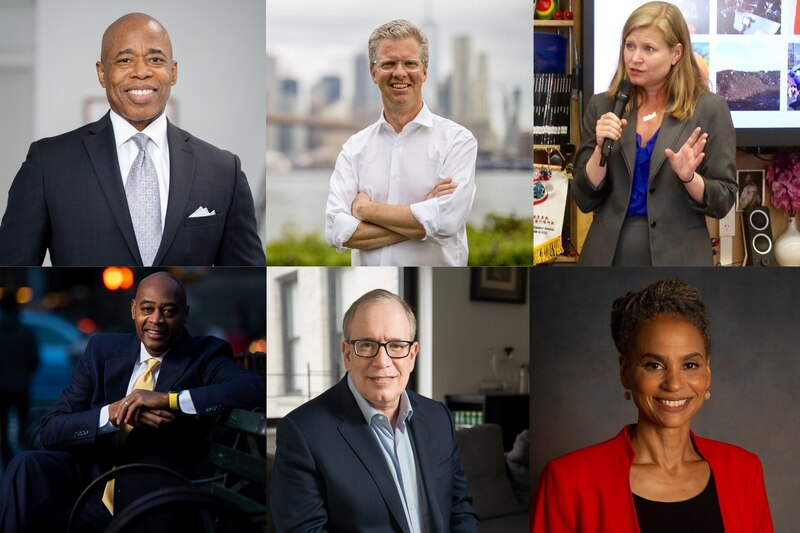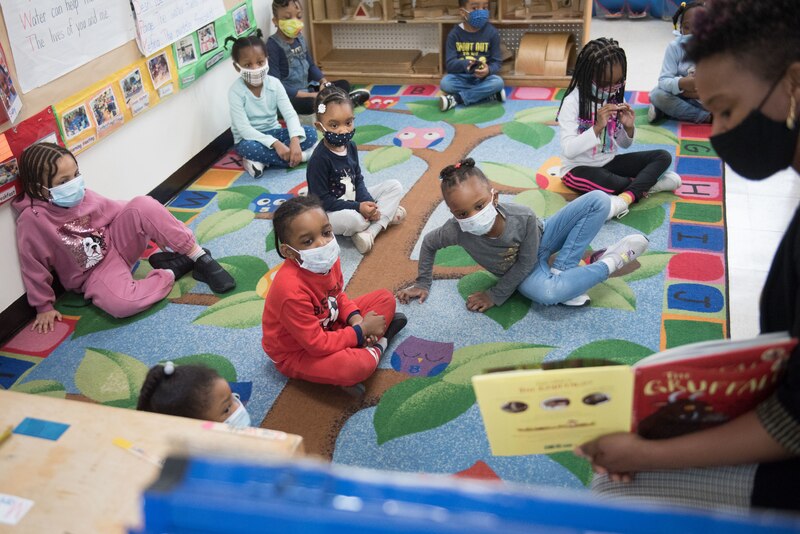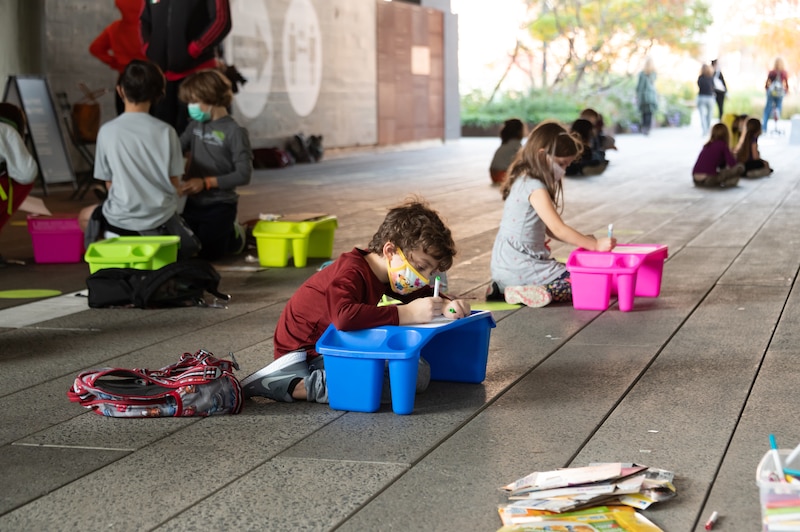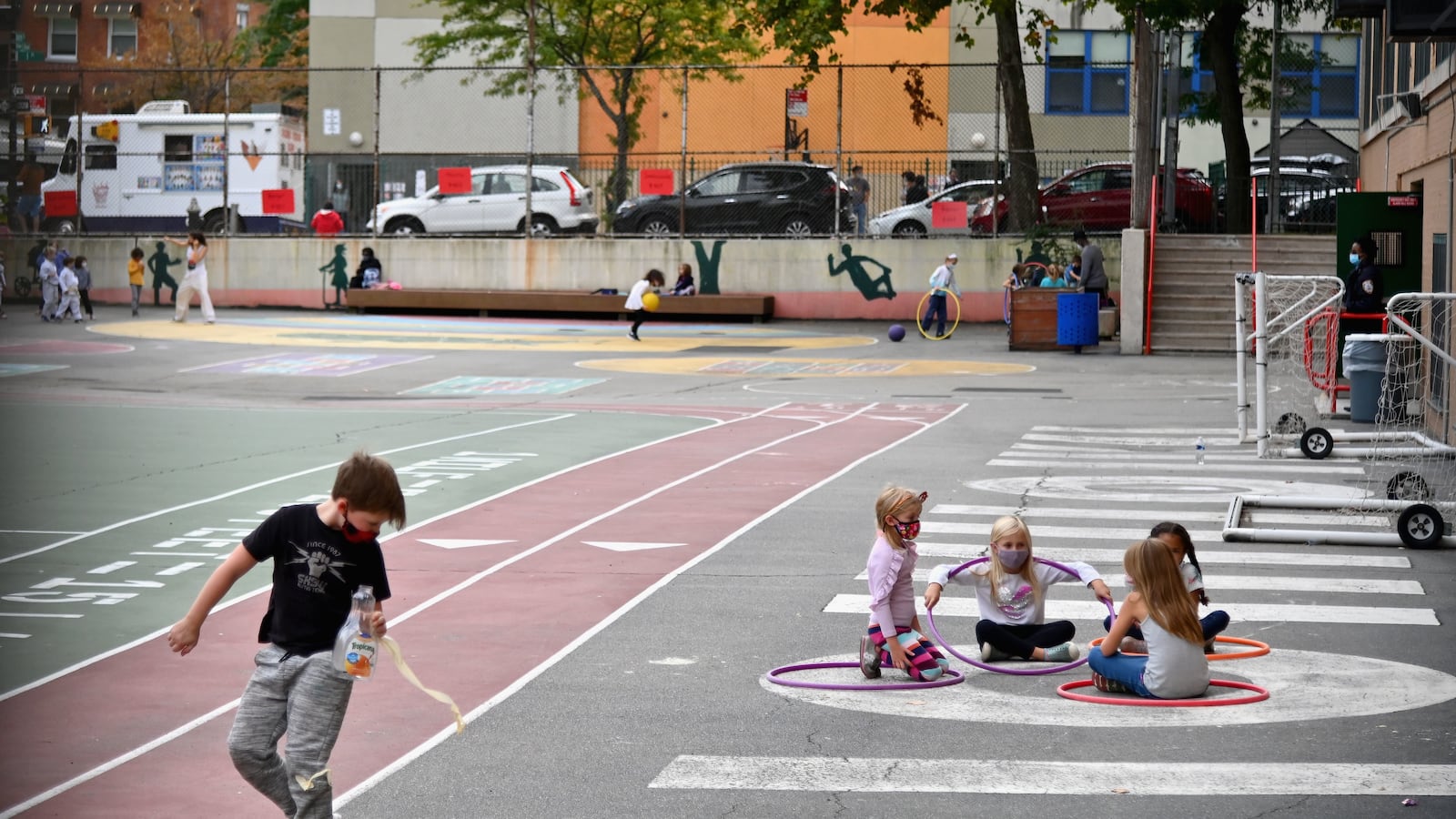When New York City last had an empty seat in the mayor’s office, the winning candidate rose to popularity in part on a signature education policy proposal: extending public pre-kindergarten to all children.
During this raucous mayoral campaign, the landscape looks incredibly different from when Bill de Blasio first took office, following a life-changing pandemic and four years under President Donald Trump.
But the needs of the city’s youngest learners are still at the forefront of many voters’ minds, as the pandemic illustrated how the stress put on the nation’s patchwork child care system hobbled working families. Women, especially, have been set back since the coronavirus gripped the country: a jobs report from December found that women made up all of the losses that month. Women of color have suffered disproportionately from the economic fallout.
Chalkbeat spoke to six of the frontrunners for the Democratic primary, a race that could decide the election in heavily Democratic New York City. We interviewed Brooklyn Borough President Eric Adams, former U.S. Secretary of Housing and Urban Development Shaun Donovan, former NYC Sanitation Commissioner Kathryn Garcia, former vice chair of Citigroup Ray McGuire, New York City Comptroller Scott Stringer, and civil rights lawyer Maya Wiley. We asked about their views on early childhood education as well as the crucial topic of youth services, which includes programs like paid summer internships for teens.
Below is a voter guide, where you will find the main takeaways from each interview, as well as links to full videos for those who want to explore deeper. Early voting begins June 12 and runs through June 20, and Primary Day is on June 22. We also rounded up the candidate’s platforms on a host of other education issues. You can read up on their positions here.

Democratic mayoral candidates Andrew Yang and Dianne Morales turned down invitations to participate.
Jump to the topics we covered: Child care access, child care affordability, early childhood education workforce, after-school and youth programs
Child care access
While New York City has made dramatic strides in expanding access to preschool for 3- and 4-year-olds, challenges remain for many working families.
It can still be a struggle to find quality care for younger children. New York City has an estimated 15 slots for infant and toddler care per 100 children. Capacity went down in middle-income communities between 2011 to 2017, according to the advocacy group Raising NY.
And even those with children in the city’s free pre-K programs may face a child care crunch after the traditional school day ends around 2 p.m. and during summer break. City-subsidized preschool programs have pushed for more seats in centers that provide longer hours and care year-round.
Eric Adams
Adams called himself a “big believer” in opening up school buildings beyond the regular day, pointing to his efforts as Brooklyn Borough president to give free space on school campuses to organizations that provide after-school programming. But he did not have specific plans for providing extended hours for child care.
He proposes expanding access to child care by making it more affordable for centers to open. He wants to tap into the city’s own inventory of building space and give incentives to developers who dedicate free or low-cost space to child care providers. Adams also proposes to drop permit costs for programs and help centers bring on new staff more quickly by speeding up the background check process. The background check backlog has hampered many child care and after-school programs.
Shaun Donovan
Donovan said it’s “absolutely the right goal” to make extended-day and full-year care available for all children, but he suggested that such an expansion — and the timeline for accomplishing it — would depend on federal funding.
His campaign’s centerpiece vision — “15-minute neighborhoods” — would make everything from public transportation to healthy food to quality child care available within a 15-minute walk from every New Yorker’s home.
To help accomplish that, he would focus on the business side of running a child care facility, with centralized support for providers, many of whom are small business owners who come from the communities they serve.
“To be very specific, the bookkeeping, the applying for assistance, the payroll, and accounting — all of those things need to be things that we help many of these centers with so that they can focus on our kids,” he said.
Kathryn Garcia
Garcia said that extended child care hours should be available to “anyone who needs it to support them being able to go to work.” However, she stopped short of saying it should be universal.
She wants to expand free child care for low-income families and said building out the system should “accommodate what parents’ choices are going to be.” In New York City and across the country, child care is provided through a patchwork of home-based programs and center-based programs.
“So it is a plan that is multipronged and needs to move forward in a way that ensures that we are working with families to get them what they need,” she said.
Ray McGuire
McGuire wants to offer operating funds, grants, and capacity-building support to early childhood care providers so that they can open more centers. It’s unclear how much he’d like to spend on this initiative, which would focus on areas currently facing the greatest unmet need for child care slots.
McGuire also said he’d provide training support for educators to ensure that programs are high quality and pledged to work with institutions such as CUNY to make that happen.
He added that he’d like to see the school year and school day extended, and not just for pre-K students, saying those costs will pay off in the long run if children are cared for in safe, engaging programs rather than being free to get into “mischief.”
“We need to invest now or pay later. I’d rather invest today,” McGuire said.
Scott Stringer
Stringer has proposed one of the most detailed child care plans, which he unveiled well before announcing his current run for mayor. As the city’s comptroller, he partnered with state legislators to call for a new payroll tax that would be used, in part, to cover $500 million in capital investments to create more space to open child care centers. Stringer’s plan prioritizes 10 communities most lacking in child care options, including Tottenville on Staten Island, Bushwick in Brooklyn, and Sunnyside in Queens.
“We can’t reopen the same way we closed. Part of the reason why we need child care is so people — mostly women, mostly women of color — can get back into the workforce,” he said.
Stringer’s plan acknowledges the need for more convenient child care hours for working families, but it’s unclear if he would support a universal expansion of the school day and year.
Maya Wiley
Wiley proposes to invest $500 million into “community care” centers, as well as stipends to families to pay for child care. The centers would be intergenerational hubs that provide a range of services, from free child care to senior care and job training. She proposes paying for this model by diverting money from police department hiring and tapping unspent federal funds.
Wiley calls for centers in each borough that can serve up to 300,000 people in the first year — and up to 1 million at full capacity. She wants to survey residents to determine what services to offer, and invest money through a proposed $10 billion capital plan for the city, opening up centers in schools, existing community centers, and new sites.
She called for “more access to longer hours” at city child care programs.
Wiley also noted that many child care providers are privately run small businesses, and a large number of them have been devastated by enrollment drops and closures related to COVID. She said helping small businesses in the wake of the pandemic will be “a really important part of our economic recovery.”

Child care affordability
The expansion of universal pre-K for 4-year-olds saves New York City families an estimated $10,000 a year, according to the de Blasio administration. More and more students are also enrolling in free preschool for 3-year-olds, as the city expands its 3-K program to every school district next year. De Blasio is relying on one-time federal stimulus for the latest expansion, which still leaves the city about 20,000 seats short of reaching every 3-year-old.
Still, care for younger children remains one of the most expensive line items in families’ budgets, accounting for 31% of median household income for those with young children. In some Bronx neighborhoods, the cost can consume 65% of a household’s income.
Meanwhile, a Byzantine approval process and bureaucratic backlog in getting families approved for subsidized care leave many waiting for vouchers to help pay for child care — even while seats in centers go empty.
Eric Adams
Adams hopes that providing free or low-cost space for child care programs will result in cost savings that get passed on to families. But he also wants to expand the city’s earned income tax credit, though he does not say by how much. Adams also proposes to expand the voucher program, but his plan doesn’t say by how many slots or whether eligibility might change.
As for the city’s current voucher landscape, Adams said the city needs to do a better job communicating with families about availability. He suggested tapping into the city’s census outreach teams, which hosted teach-ins and conducted phone- and text-banks to help spread the word in ways that resonate across languages and cultures.
“We should be using these teams year-round to continually push out information,” he said.
Shaun Donovan
Donovan said he supports making 3-K universal. He did not provide details for how he would pay for such an expansion or how quickly it might happen.
On vouchers, Donovan said the city needs to partner more effectively with social service organizations to help families know which programs they’re eligible for. Those kinds of groups “can be the best partners to reach families and make sure that we are signing them up quickly, overcoming language and trust barriers that often stand in the way of families even applying in the first place, to make sure that we have a robust pipeline of applicants,” he said.
Kathryn Garcia
Garcia proposes to offer free care for children from birth to age 3 to any family making under $70,000. She did not outline how the city would pay for those services but said strong early childhood care is “critical” to ensure students are ready for school and that families can work. The state legislature recently proposed a similar plan.
To help make sure more families can get the care they need, she said the city needs to streamline the voucher process “so that we’re not spending our time filling out forms, but spending our time making sure a kid is in that early childhood placement.” For example, she questioned why parents are repeatedly asked to go through an onerous process to verify their income levels when applying for different types of assistance.
“This is just government bureaucracy run amok,” she said.
Ray McGuire
McGuire said he would “guarantee every parent access to quality early child care and education,” serving children starting from birth to 4 years old, but he provided few specifics. He said that families would pay for care on a sliding scale based on their income level. Those on the lowest end could enroll their children for free, but McGuire did not say what the income threshold would be or how much families could expect to spend.
He suggested his program could run like existing voucher programs but said that he would ”cut bureaucracy” to address backlogs in the current system, without providing specifics on how he’d tackle that issue.
Scott Stringer
Stringer acknowledged the city needs to “manage the voucher system well” but also pointed to onerous federal regulations around that system. A better solution, he said: “A massive expansion of child care is how we, I think, satisfy the demand.”
He has called on the city to extend free child care for the lowest-income families. Others would pay on a sliding scale, up to 12% of household income for those earning around $100,000 for a family of four. In all, he estimates the city could serve 34,000 more children. Like his plan to open more centers, this would be funded by a tax on businesses with payrolls of more than $2.5 million.
Maya Wiley
Wiley proposes to give $5,000 in grants to 100,000 of New York City’s neediest families. She calls this “care income.” The money would be distributed based on a yet-to-be-determined formula and could be used to pay for informal care that so many parents rely on — including from a neighbor or extended family members. Parents who decide to stay home to care for their children could also use the money to offset expenses. Undocumented immigrants would also be eligible “because every last resident in the city deserves quality care for their family members,” she said.
The idea is to compensate caregivers — usually women — for vital work that often goes unpaid, Wiley said.
When it comes to addressing issues in the voucher system, Wiley said that it is riddled with “so many hurdles” that “it becomes next to impossible” for families to navigate the process. She hopes her proposed care centers could remove some of those barriers by locating community organizations and government agencies within them.
“It’s a big resource to have a one-stop-shop center that starts to streamline how that’s done and makes it easier for families,” she said.
Early Childhood Education workforce
Some preschool teachers who work in the city’s privately run, publicly subsidized pre-K programs are paid dramatically less than their counterparts in public schools, which can cause retention and recruitment challenges for programs. New York City has taken steps to address these gaps by boosting some teachers’ salaries by as much as $20,000 after educators threatened a strike.
But large disparities remain. Teachers who work for community-run pre-K sites don’t get the same pay bumps for longevity as public school teachers, and many work longer hours and throughout the summer. And the latest pay deals did not include teachers in certain special education pre-K programs, making those who work with some of the most vulnerable students among the lowest-paid teachers.
Eric Adams
Adams said he supports the push for pay parity, and that includes equal benefits for teachers. He said he wants to compensate teachers for their years of experience and provide financial incentives for them to get credentialed but didn’t provide specifics about how to do that.
“It’s almost humiliating what we are paying these professionals,” he said.
He said the city should direct an influx of state and federal money to pay for the increases. If elected, Adams said there should be a clear path towards parity within one to two years of his term as mayor.
Shaun Donovan
Donovan said he’d like to see equal pay in his very first year in office for pre-K teachers in different settings. The former Obama White House official said he’d tap into his “deep relationships” in the federal government to try to secure more investments in the early childhood workforce.
He also wants to replicate existing programs that offer tuition assistance, removing a financial barrier that can stand in the way of many child care workers from earning their degrees, and with them, higher pay.
“To do it, I think it’s not just going to take the resources; it’s going to take the partnerships as well,” Donovan said.
Kathryn Garcia
Garcia said that more equitable pay for early childhood educators also helps ensure that high-quality teachers staff centers. “I’m a big believer in making sure that we are creating a more equitable environment for everyone so that everyone can thrive,” Garcia said.
Any pay boosts, she said, would have to be a part of union negotiations and what’s known as pattern bargaining — when pay provisions negotiated by one union also apply to others.
But that didn’t happen when the city agreed to raise substantially certain pre-K teacher salaries in 2019. At that time, officials went around the normal contract negotiation process after teachers threatened to strike.
Ray McGuire
McGuire said that raising salaries goes hand-in-hand with his plans to expand access to child care because better-paying jobs mean that providers can grow. His timeline is “immediate,” McGuire said, but he did not provide more specifics.
Scott Stringer
Stringer said one of his top priorities as mayor would be “to implement a massive pay parity plan to get the workers the resources they need.” He said he would propose funding increases for just that in his very first budget. He said teacher pay is crucial when it comes to program quality — and his expansion plans.
“It’s not an afterthought. You can’t go forward unless you do it,” he said of raising salaries.
Pointing to an influx of resources coming to the city, Stringer said, “We have buckets of money.”
“I’m less concerned about how to pay for it as I am about how to implement it,” he said, adding that he would work with community-based providers and others on the ground.
Maya Wiley
Wiley said she’d like to see pay parity achieved within the first two years of her administration — if not sooner. She said there is a “real opportunity now” with the Biden administration to boost pay in programs such as the federal HeadStart program. In his American Families Plan, Biden has proposed to hike pay to at least $15 an hour for early childhood educators across the country.
She also said that centers should have equal access to other resources that support quality care, noting that the city’s deeply segregated programs can also result in uneven quality.

After-school and youth programs
Nonprofits that provide after-school and summer youth programs typically have to fight each year for their funding to be included in the city’s budget. Those programs have also been the target of cuts: When the pandemic first struck, the city slashed some 40,000 slots from the summer youth employment program, which provides paid internships to teens and young adults. The mayor’s proposed budget would restore funding for this summer.
Advocates have called for more stable funding for these programs to be built into the city’s budgets, so they and families can plan ahead. Many would also like to see summer youth employment expanded to become universal for any teen who wants a job, and for after-school care to be open to any student who needs it.
Eric Adams
As borough president, Adams said he allocated $2 million towards a pilot program to provide community organizations space in school buildings. He wants to expand that program, which will allow nonprofits to provide after-school opportunities like sports, especially in underserved areas. “Because when you really think about the cost, rental of space, use of a space — that is really some of the largest parts of actually having an overhead,” he said.
Adams has also called for schools to be open year-round with services for students and families. In addition, he would like to see a universal tutoring program but didn’t say how he would make it happen.
Shaun Donovan
Donovan has called for growing the summer youth employment program to include 150,000 slots. (According to advocate estimates, that would be enough to serve every youth who wants one.) He wants every high schooler to have at least one paid internship, apprenticeship, or other summer job before they graduate. He says those opportunities must provide exposure to “meaningful” careers. To make sure those opportunities are available, Donovan proposes to partner with organizations that already offer training and mentoring to high school students.
Kathryn Garcia
Garcia said she would expand after-school and other youth programs by tapping the American Rescue Plan, which earmarks billions of federal dollars intended to help students catch up from more than a year of interrupted learning due to COVID. She said nonprofits will be crucial partners in doing so and said she’d like to replicate models that incorporate work experience into their academic programs.
She said paid internships should be “available to anyone who wants it.” But she added that they should be “thoughtful opportunities” for youth “so that kids really have an idea about what the work world will look like.”
Ray McGuire
McGuire, a former corporate executive, promised to “leverage my relationships, both big and small,” to build a robust summer jobs program for any high schooler who wants a position. He would also like to see after-school and summer school programs significantly expanded to help students fill in gaps after two academic years interrupted by COVID. To do that, he said he’d like to funnel money to nonprofits to expand opportunities in theater, coding, academic recovery, and other areas.
Scott Stringer
Stringer proposes opening youth employment programs to any student who wants to participate. He has also proposed spending $200 million to make sure every child in K-8 has access to an after-school program.
“To do anything less is just a disservice, and I think creates an unequal education,” he said, adding that he’d like to build multiple years of funding into the city’s budget so that families and providers can be sure they’ll be able to operate in the longer term.
Stringer said that such a significant expansion of after-school programs would likely strain providers and that the city will need to find creative ways to alleviate that strain.
“There’s a pressure point because they can’t expand because of finances and their own capacity. And we need to leverage different relationships we have in the city, through procurement, through other means, to get them to a place where they can serve more people,” he said.
Maya Wiley
As part of a platform to reduce shootings, Wiley has called for doubling the number of summer youth employment programs to serve young people at the highest risk of gun violence. That would mean dedicating 10,000 slots to those young people. She said that communities with the highest unemployment rates also tend to suffer disproportionately from gun violence.
“We must make it easier to get a job than a gun in our communities,” she said.
She also supports more after-school programs “for all our youth” and wants to see school buildings used for programming “all year long.” She said she’d like to see longer-term funding assured for providers, “to ensure that we’re building and growing them appropriately and in ways that are meeting the needs of our kids.”
This work was made possible with support from the Campaign for Children (C4C).

